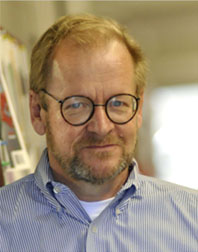Research Interests
Enzymes catalyze a remarkable variety of chemical reactions with extremely high rate enhancements and very selective substrate specificity. The research efforts in our laboratory are directed towards a more complete understanding of the fundamental principles involved in enzyme-catalyzed chemistry and the dependence on protein structure. The pursuit of this information will provide the framework for the rational and combinatorial redesign of these complex molecules in an effort to exploit and develop the properties of enzyme active sites for a variety of chemical, biological, and medicinal uses. The techniques that we are using to solve these problems include steady-state and stopped-flow kinetics, NMR and EPR spectroscopy, X-ray crystallography, and the synthesis of inhibitors and suicide substrates. We are also using recombinant DNA methods to construct new proteins with novel catalytic properties. These efforts are currently being directed to the reactions catalyzed by phosphotriesterase and enzymes involves in the degradation of lignin and the metabolism of novel carbohydrates from the human gut microbiome.The phosphotriesterase enzyme catalyzes the hydrolysis of organophosphate insecticides and other toxic organophosphate nerve agents. We have discovered that the active site of this protein consists of a unique binuclear metal center for the activation of water. We are now investigating the structure and properties of this metal center as a model system for the evolution of enzyme structure and function. Toward this end we have mutated the active site of this enzyme in a research project to create novel enzymes with the ability to detect, destroy, and detoxify various chemical warfare agents such as sarin, soman, and VX. The Raushel laboratory is also engaged in a large scale research project that is focused on the development of novel strategies for the discovery of new enzymes. We are applying these methods to more clearly understand how complex carbohydrates are metabolized within the human gut microbiome in an effort to discover new metabolic pathways and new enzyme catalyzed reactions.
Educational Background
- B. A., 1972, St. Thomas College
- Ph. D., 1976, University of Wisconsin Madison
- Postdoctoral Fellow, 1976-80, Pennsylvania State University
Awards & Honors
- New Investigator Research Award from NIH
- Research Career Development Award from NIH
- Repligen Award in Biological Processes from ACS
- Fellow of AAAS
- Fellow of American Chemical Society
- Distinguished Achievement Award for Research from the Association of Former Students
- Powell Professor of Science
- Gordon Hammes ACS Biochemistry Lectureship
- Southwest Regional ACS Research Award
Selected Publications
A. Vladimirova, Y. Patskovsky, A. A. Fedorov, E. V. Fedorov, J. B. Bonnano, R. Toro, B. Hillerich, R. Seidel, N. G. J. Richards, S. C. Almo and F. M. Raushel, "Substrate Distortion and the Catalytic Reaction Mechanism of 5-Carboxyvanillate Decarboxylase" Journal of the American Chemical Society, 138, 826-836, (2016).
A. N. Bigley, D. F. Xiang, Z. Ren, H. Xue, D. Romo and F. M. Raushel, "The Chemical Mechanism of the Phosphotriesterase from Sphingobium sp. Strain TCM1: An Enzyme Capable of Hydrolyzing Organophosphate Flame Retardants" Journal of the American Chemistry, 138, 2921-2924 (2016).
A. N. Bigley, M. Mabanglo, S. P. Harvey and F. M. Raushel, "Variants of Phosphotriesterase for the Enhanced Detoxification of Chemical Warfare Agent VR" Biochemistry, 54, 5502-5512 (2015).
S. Ghodge and F. M. Raushel, "Discovery of a Novel Ribonuclease from Escherichia coli that Hydrolyzes 5’-Phosphorylated Fragments of RNA" Biochemistry 54, 2911-2918 (2015).
M. E. Hobbs, H. J. Williams, B. Hillerich, S. C. Almo and F. M. Raushel, "L-Galactose Metabolism in Bacteroides vulgatus from the Human Gut Microbiota" Biochemistry 53, 4661-4670 (2014).

